
I am a staff scientist at the Institute of Space Astrophysics and Cosmic Physics (INAF – IASF Palermo, Italy). My research focuses on the accretion of matter onto black holes at any mass scales and their feedback onto the surrounding interstellar medium of the host galaxy (primarily via winds) and galaxy cluster (via collimated jets).
I obtained my PhD at Radboud University Nijmegen in collaboration with SRON, the Netherlands Institute for Space Research, under the supervision of Frank Verbunt, Jelle Kaastra, and Elisa Costantini. The topic of my thesis was the composition of the interstellar medium in the Galaxy as seen through X-rays. My master thesis with Maurizio Paolillo and Giuseppe Longo at Naples University, Italy, focused on the X-ray variability of active galactic nuclei. More recently I have been 6 years in Cambridge, UK, working in the X-ray Group at the Institute of Astronomy, University of Cambridge with Prof. Andy Fabian. Before joining INAF I have been a Research Fellow for the European Space Agency in ESA/ESTEC in Noordwijk, Netherlands.
Scientific interests
Black holes: matter accretion from companion and disk winds
Active galaxies: X-ray spectroscopy and variability of outflows, warm absorbers, and persistent continuum
Clusters of galaxies: chemical evolution and turbulence estimates through X-ray spectroscopy
Interstellar medium: absorption and scattering of X-rays by interstellar gas, dust, and molecules
X-ray binaries and cataclysmic variables: disk, atmosphere and wind spectroscopy
Publications
<Link to ADS (My ORCID-associated papers)> or publication list PDF as of February 2023 below.
Curriculum Vitae
Curriculum vitae (shortened to 1 page)
Curriculum vitae (dettagliato, Italiano)
Curriculum vitae (detailed, English)
Curriculum vitae (+ publications, English)
Research group, supervision, and teaching
Leader of the SEAWIND project (Super-Eddington Accretion: Wind, INflow, and Disk): SEAWIND @ INAF
Postdoc: Peter Kosec (funded via ESA Research Programme, 2020) at IoA/Cambridge. PhD and Master students currently being supervised: Alessandra Robba, Yerong Xu and Francesco Barra at IASF/INAF-Palermo & UNIPA.
Trainees and previous PhD/Master supervisions: Elias Kyritsis (funded via LEAPS Programme) at ESTEC and Leiden University. Alessio Anitra, Anna Marretta, Vincenzo Cusimano (University of Palermo). C. Bambic, D. Dickson, T. Li, J. Zhu, M. Parker and Haonan Liu at IoA/Cambridge.
Galaxies 2010/2011 – Teacher assistant of Soeren Larsen
Relativistic Astrophysics And Cosmology 2008/2009 – Teacher assistant of John Heise and Peter Hoyng
Astrophysics laboratory of thermal X-ray plasmas 2022/present – Main teacher
Contacts
| Dr. Ciro Pinto Institute of Space Astrophysics and Cosmic Physics INAF – IASF Palermo, Via Ugo La Malfa 153 80146, Palermo, Italy | Email: ciro.pinto[at]inaf.it Email: pinto[at]ifc.inaf.it Email: ciropinto1982[at]gmail.com Phone: (+39) 091 6809 488 |
Other contacts
I have started to share my astronomical codes on the <GitHub>
 Follow me on Academia.edu or <Linkedin> , Google Scholar
Follow me on Academia.edu or <Linkedin> , Google Scholar
Highlighted scientific work
Powerful winds in X-ray binaries
Ultra-luminous X-ray sources: relativistic winds
My team has observed two black holes in nearby galaxies devouring their companion stars at an extremely high rate, and spitting out matter at a quarter the speed of light (Image credit: ESA – C.Carreau). The two black holes NGC 1313 X-1 and NGC 5408 X-1, so bright in the X-ray energy band to be known as “ultra-luminous x-ray sources”, are sucking matter from their companion stars at a rate exceeding classically understood limits, and in the process, kicking out matter into surrounding space at astonishing speeds of around a quarter the speed of light. This discovery is crucial to understand the process of accretion onto compact objects and the physical phenomena that trigger the outflows of highly energetic winds. See also press release from the <European Space Agency (ESA)>, our original article published in <Nature> and a <TV interview>.
On the right there is a brand-new and more efficient contours visualisation of an outflowing plasma blowing at 17% of the speed of light in a supersoft ULX in the NGC 247 galaxy with very high significance achieved thanks to a deep observing campaign in the ESA’s XMM-Newton satellite (Pinto et al. 2021).
See e.g. my Webinar on ULXs and why Athena is the way to go
Exploding white dwarf Nova V2491 Cygni: 3000 km/s winds
A pioneer work. The X-ray spectrum at the outburst peak of this nova obtained with the RGS of XMM-Newton, shows deep absorption by ions of a wide range of ionization (e.g. O I-to-VIII). The deep absorption lines of the X-ray spectrum are divided in two main groups: the low-ionization absorption lines are at rest (v = 0 km/s) and are mostly due to the interstellar medium; the high-ionization absorption lines are blueshifted by about 3300 km/s and are produced in the ejecta. We model this expanding envelope with photo-ionized outflowing shells. The abundances of the shells indicate that they were ejected from an O-Ne white dwarf. Variations on time scales of hours in the X-ray spectrum are caused by a combination of variation in the central source and in the column density of the ionized shells. Our phenomenological model gives the best description so far of the supersoft X-ray spectrum of nova V2491 Cyg (Pinto et al. 2012b).
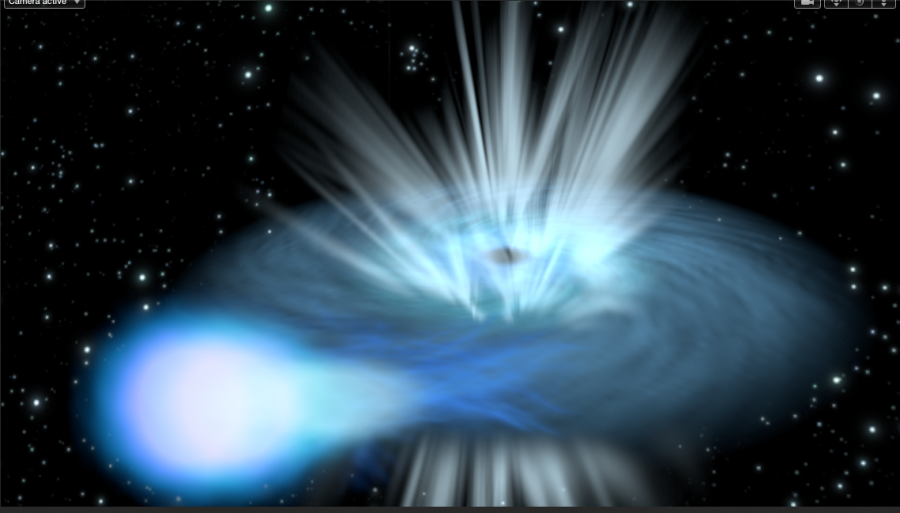
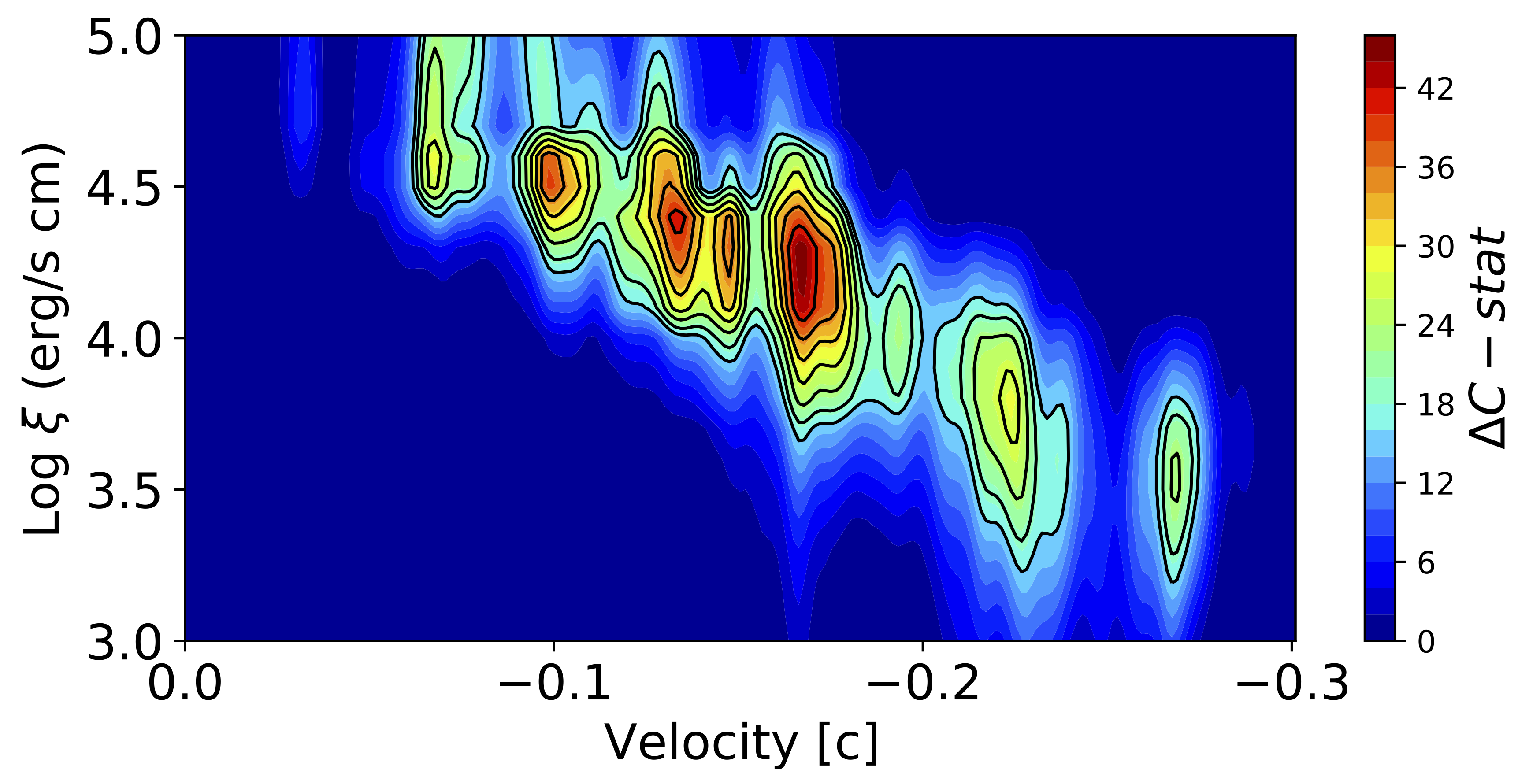
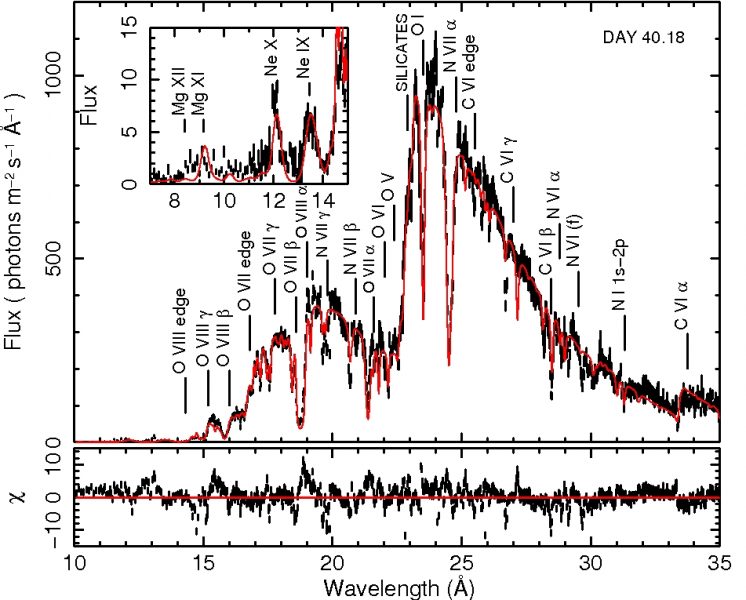
Turbulence in galaxy clusters
Hitomi first light of Perseus cluster of gakaxies: a surprisingly quiescent atmosphere
The Perseus galaxy cluster is filled with a hot X-ray-emitting gas, as seen in this image from NASA’s Chandra X-ray Observatory. Astronomers using the Soft X-ray Spectrometer aboard the Hitomi satellite have, for the first time, mapped the motion of this gas and determined its velocity structure across a large part of the cluster. The square overlay shows the area observed by Hitomi. The X-ray spectrum is also shown with emission from helium-like iron (that is iron with only 2 electrons) on the left and hydrogen-like iron (iron with only one electron) on the right. The narrowness of the emission lines shows that random motions in the 50 million K hot gas in the Perseus cluster core are only 164+/-10 km/s along the line-of-sight. This represents a dramatic improvement in the measurement precision of the velocities which are crucial for determining the total masses of clusters and the energy flow from the accreting black hole at the cluster centre. See also press release from the <European Space Agency (ESA)> and our original article published in <Nature>. (Copyright: Background: NASA/CXO; Spectrum: Hitomi Collaboration/JAXA, NASA, ESA, SRON, CSA).
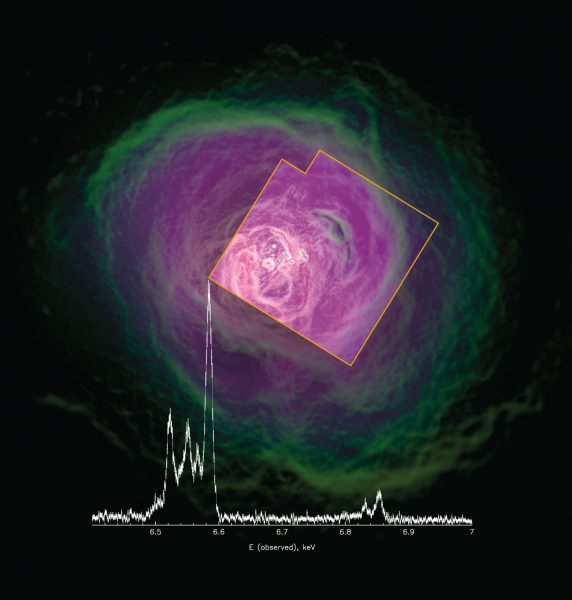
Cooling in ellipticals and galaxy groups
Fornax A: an unusual “cooling” galaxy with a very powerful radio source
NGC 1316 (also known as Fornax A) is a lenticular galaxy about 60 million light-years away in the constellation Fornax. NGC 1316 is a radio galaxy. It is the fourth-brightest radio source in the sky (as seen at 1400 MHz). NGC 1316 is comparable to the giant elliptical galaxies found in the centers of other clusters of galaxies and hosts a hot gas with temperatures of several million degrees that strongly emits in the X-ray energy band. The image to the right shows the high-resolution XMM-Newton/RGS spectrum where I discovered -for the first time in an individual galaxy/cluster- the O VII lines which indicate gas cooling below 0.4 keV. This discovery is very useful to study the cooling of the intra-cluster/-group medium.
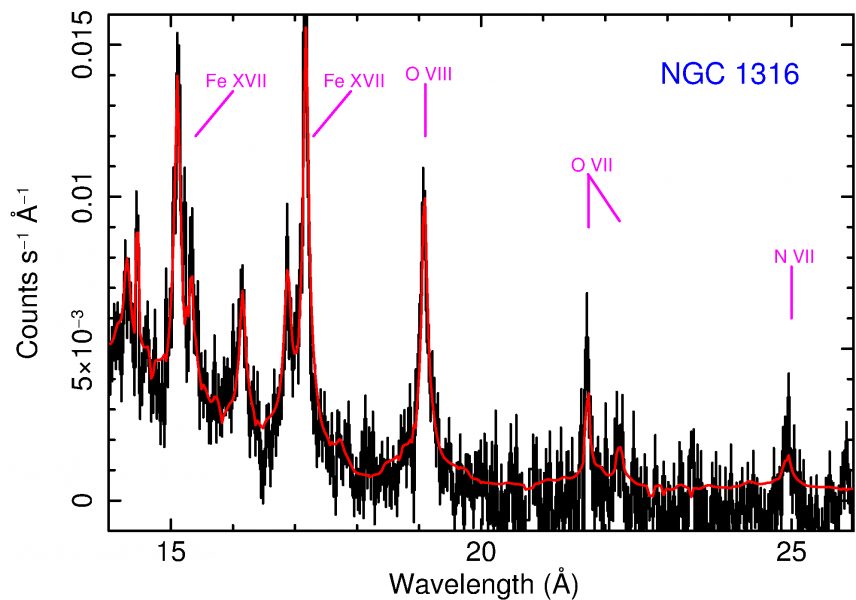
Interstellar absorption: the O I K-edge
The interstellar matter can be modeled with a multi-phase gas plus dust grains. The gas has 3 main phases: neutral (O I), weakly ionized (O II-III) and highly ionized (O VII-VIII). Dust grains are still a quite open field. Both silicates and/or water amorphous ice are good candidates (Pinto et al. 2010-12a,c).
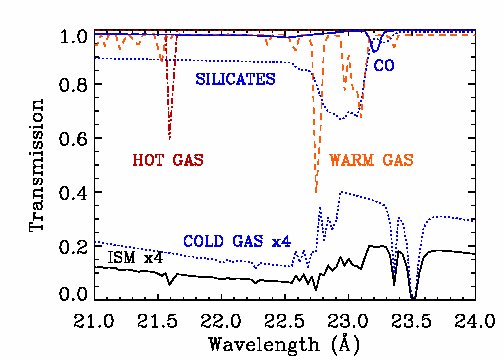
Galactic interstellar forest at different velocities towards AGN Mrk 509
Below there are the UV absorption lines of the interstellar and circumgalactic medium in the line of sight towards AGN Mrk 509 as observed Hubble Space Telescope and FUSE. The spectrum (plotted in the velocity space) shows that 7 interstellar clouds at rather different velocities are absorbing the AGN light. The mildly ionized gas is modeled with a photo-ionization code, while the O VI heavily gas is modeled with collisional ionization. The chemical and physical analysis of these lines help locating these clouds with respect to our Galaxy (Pinto et al. 2012a).
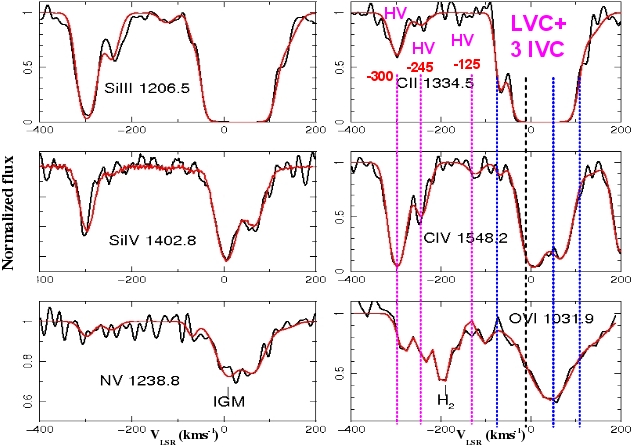 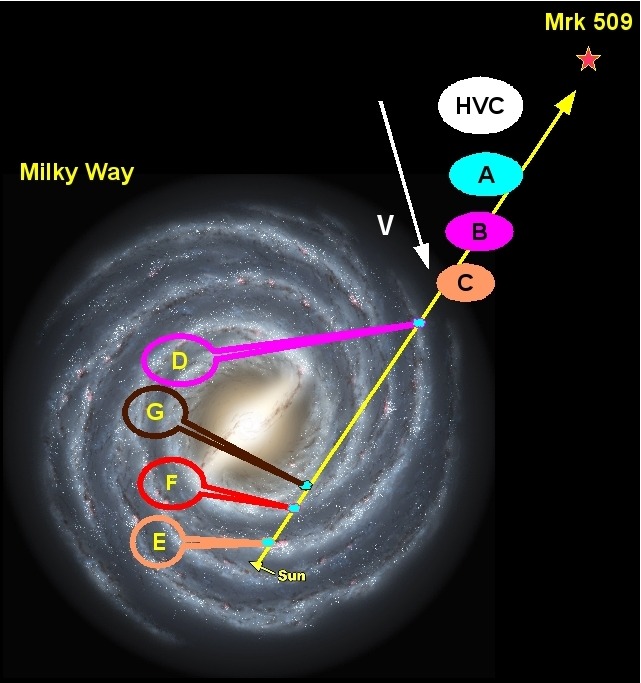 |